by Lisa Cooke | May 13, 2017 | 01 What's New, FamilySearch, Research Skills |
I have thoroughly enjoyed having Amie Tennant as a blogger for the past year. In her final blog post for Genealogy Gems she takes us on a tour of her home state’s digital records. Then she will be turning all of her attentions to her own genealogical certification. Thank you Amie for all of your helpful and thoroughly enjoyable posts! – Lisa Louise Cooke
Ohio genealogy research goes digital. You can now virtually walk into any courthouse in Ohio with the click of the mouse. Check out the amazing browse-only databases at FamilySearch for Ohio and other states, and take your family history research to the next level.
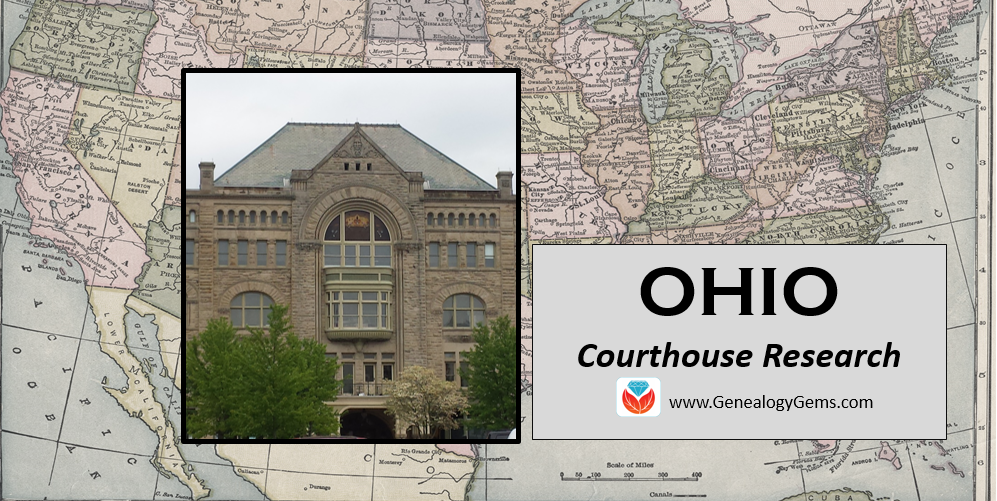
I use FamilySearch.org to search courthouse record books all the time. In particular, the Ohio Probate Records, 1789-1996 now have nearly 7 million digital images of county record books such as wills, estate files, guardianship records, naturalization records, minutes, bonds, and settlements. In fact, many other states have their court record books online at FamilySearch, too. So, why haven’t you noticed before?
Browse-only Databases vs. Indexed Databases
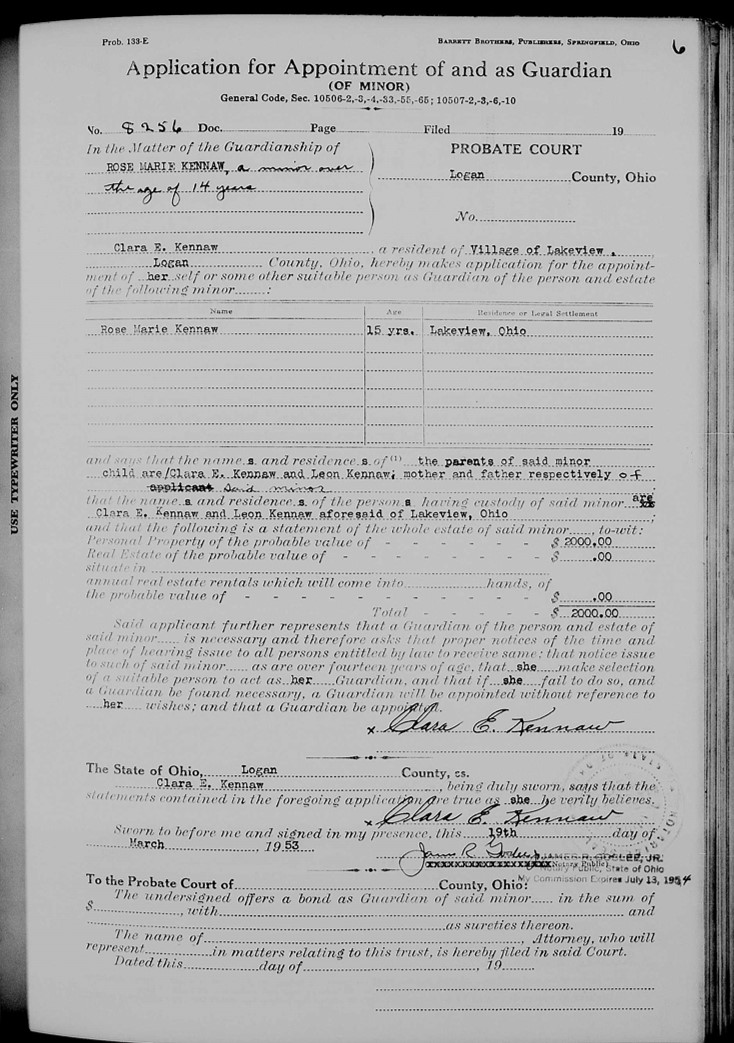 You may have read our previous post on step-by-step instructions to using browse-only databases at FamilySearch. If you didn’t, you should know that when you are searching for records at FamilySearch using the traditional search fields, you are only searching for records that have been indexed. In other words, there may be thousands of records you need on the site, but you won’t find them. They have not been indexed by a searchable name, place, or date. Instead, you need to go in the virtual “back door.”
You may have read our previous post on step-by-step instructions to using browse-only databases at FamilySearch. If you didn’t, you should know that when you are searching for records at FamilySearch using the traditional search fields, you are only searching for records that have been indexed. In other words, there may be thousands of records you need on the site, but you won’t find them. They have not been indexed by a searchable name, place, or date. Instead, you need to go in the virtual “back door.”
Step 1: First, go to FamilySearch and sign in. Next, click Search at the top right. Now you will see a map of the world. Click on the desired location. I have chosen the U.S., but you can choose any country you are interested in.
Step 2: Once you choose your desired country or continent, a pop-up list will be available and allow you to choose the state (or country) you wish to search in. In this case, a list of the U.S. states appears and I clicked on Ohio.
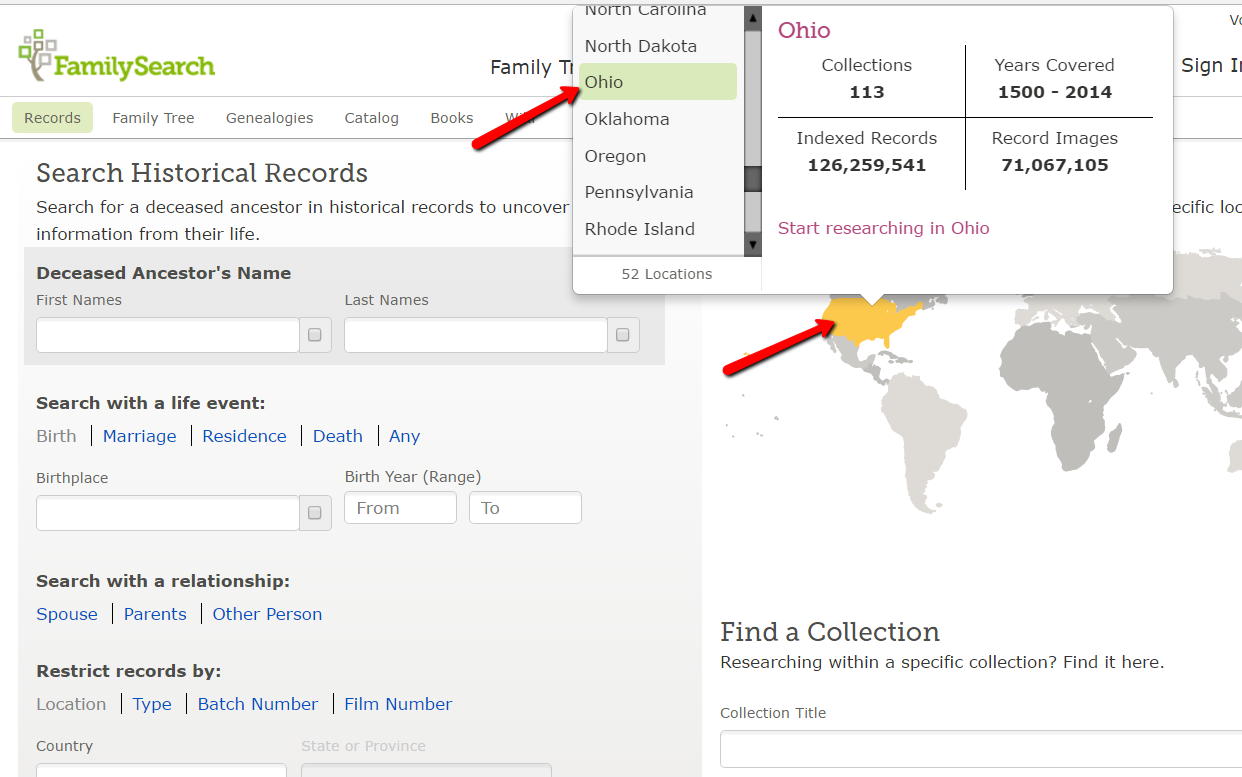
Step 3: The system will direct you to a new page. You will first see the Ohio Indexed Historical Records. These are the records and collections that have been indexed and are searchable by name, date, and place. Though these are great, they are not the record collections I want to share with you today.
Instead, scroll down until you see the heading Ohio Image Only Historical Records. You will notice several databases such as cemetery records, church records, naturalization records, etc. All of these are browseable. That means you will use them like you would microfilm.
Step 4: I want to bring your attention to a specific record collection, so scroll down even further until you see Ohio Probate Records, 1789-1996. Click it.
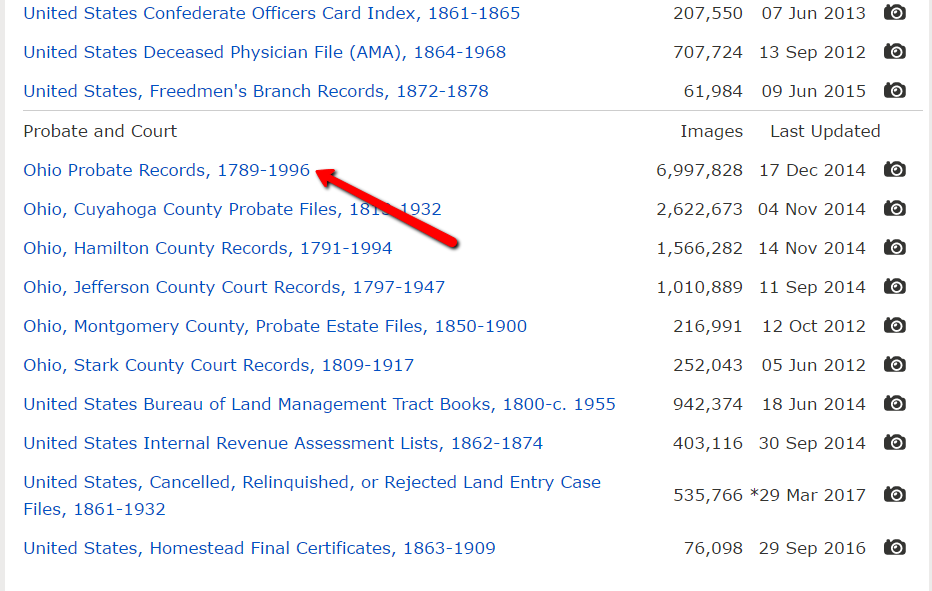
At the next screen, you will see you can browse the 6,997,828 Ohio probate records and you are probably thinking, “What!? I can’t possibly browse through nearly 7 million records!” But, you can, so go ahead and click it!
Step 5: At the new screen, you will see everything is broken up into counties. Click on the county you are interested in researching. You will next see a list of possible record books available for that county. Each county will vary, so where you may find guardianship records available in one county, you might not find them in another.
Ohio Genealogy Research at the Courthouse
As a refresher, courthouse research is often imperative to thorough genealogy research. Here is a helpful chart of the type of information you may find in these types of court records. Be sure to remember: records and the amount of information they contain change over time.
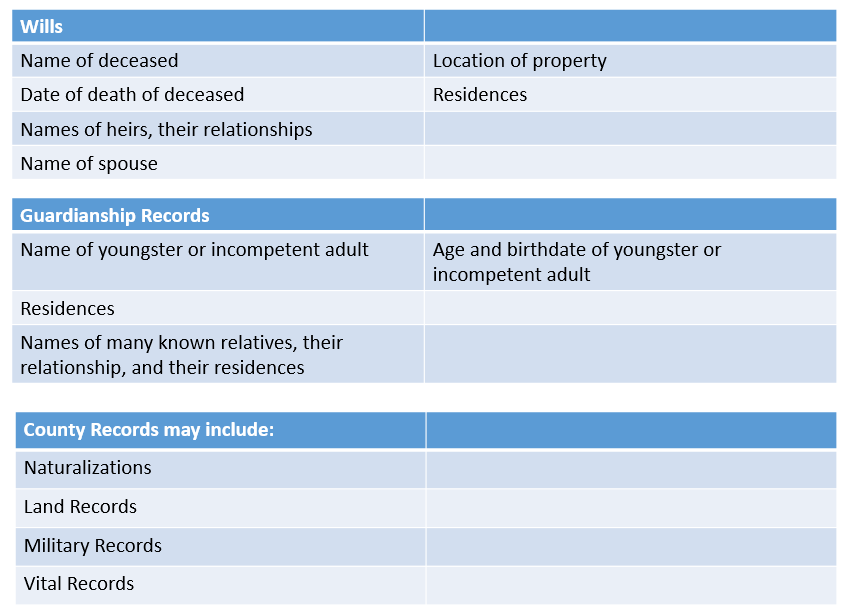
More on Courthouse Research Techniques
Are you looking to understand the value of courthouse research and how to use those records to overcome brick walls in your family tree? Read 4 Ways to Power Up Your Courthouse Research Skills from our own Sunny Morton.
by Lisa Cooke | Mar 11, 2016 | 01 What's New, Records & databases
Here’s our weekly roundup of new genealogy records online. Do you see anything you should be searching for your ancestors?
ENGLAND – LAND AND TAX. About a quarter million land tax and valuation records for Plymouth and West Devon (1897-1949) are now searchable for Findmypast.com subscribers. Transcriptions and images can reveal an ancestor’s owner/renter status, property location and size, property use and more.
US – ARIZONA VOTERS. A new database of Arizona voter registrations (1874-1932) is available at Ancestry.com. According to the collection description, “This database consists of Great Registers [lists produced from voter registrations] compiled by county recorders for each county in Arizona, by district. They list the names of eligible voters who registered to vote within the state of Arizona.” In this database you’ll see the state’s transition to female suffrage in 1912.
(1874-1932) is available at Ancestry.com. According to the collection description, “This database consists of Great Registers [lists produced from voter registrations] compiled by county recorders for each county in Arizona, by district. They list the names of eligible voters who registered to vote within the state of Arizona.” In this database you’ll see the state’s transition to female suffrage in 1912.
US – CALIFORNIA PASSENGER ARRIVALS. Over 375,000 names have been added to an existing collection of free FamilySearch.org passenger arrival records for San Francisco, CA (1954-1957). These include inbound passengers, crew lists and changes in crew.
US – DELAWARE WILLS AND PROBATE. Ancestry.com has updated its collection of Delaware Wills and Probate records (1676-1971). The indexed images now span nearly 300 years and include records from all counties (some locales and time periods are not included). Over 134,000 names are indexed.
(1676-1971). The indexed images now span nearly 300 years and include records from all counties (some locales and time periods are not included). Over 134,000 names are indexed.
US – MASSACHUSETTS VITAL RECORDS. Now available to search for free on FamilySearch.org is a new collection of indexed images of Massachusetts delayed and corrected vital records. Spanning about 150 years (1753-1900), the collection is relatively small (31,710 indexed names) but often delayed and corrected vital records can be brick-wall busters!
Use these Google Gems to Find Records You Need
 Google Search Tips 101: Keyword Search Tips
Google Search Tips 101: Keyword Search Tips
2 Mysterious Deaths in the Family? How to Google for Answers
Google Alerts for Genealogy
by Lisa Cooke | Nov 25, 2016 | 01 What's New, Records & databases
Genealogical records and research for your Denmark ancestors has just gotten a little easier! New and updated genealogical collections for Danish genealogy have been added to FamilySearch. Also new this week, new and updated records for Sweden, Hungary, Britain, and Ireland.

Denmark – Census
It was truly a Danish delight when we heard the 1916 Denmark Census is now available at FamilySearch. Danish genealogy is just a bit easier with the availability of this census, especially when paired with the already published 1911 Denmark Census, also at FamilySearch.
This is an every-name index to the 1916 census of Denmark. This index was created by MyHeritage from images provided by the National Archives of Denmark. The collection at FamilySearch includes an index or abstract version in English and a digital image of the original.

This census was taken for the countries of Denmark, the Faroe Islands, Greenland, and the Danish West Indies, however, only the records for Denmark are available at FamilySearch. The enumeration for Denmark was divided into three sections with a different form for each of the sections: Copenhagen city, other cities, and rural areas.
This census names each individual in the home and includes: sex, calculated birth date and year, marital status, relationship to head-of-household, and residence.
Other genealogy record collections for Denmark can be found on FamilySearch, too. See the entire list here.
Sweden – Church Records
FamilySearch has four Swedish church record collections that have recently been updated. Church records are especially helpful when civil records such as birth, marriage, and deaths, are not available. Check out these four updated collections and their titles below.
| Sweden, Västmanland Church Records, 1538-1901; index 1622-1860 |
43,976 |
|
| Sweden, Värmland Church Records, 1509-1925; index 1640-1860 |
Browse Images |
|
| Sweden, Skaraborg Church Records, 1612-1921; index 1625-1860 |
Browse Images |
|
| Sweden, Västerbotten Church Records, 1619-1896; index, 1688-1860 |
36,337 |
|
Hungary – Civil Registration
More records have been added to the Hungarian Civil Registration records at FamilySearch as well. This collection includes the years 1895-1980.
The records are bound volumes of pre-printed forms with event information recorded by hand. From 1895 through 1906, the forms are one page per event, but beginning in 1907 each event occupies one row in a printed table, so there are multiple events recorded per page. The records are in Hungarian.
Civil registrations include birth, marriage, and death records. You may be able to find the following information in each of these groups:
Birth records:
- Date and place of birth
- Name of child
- Gender and religion
- Parents’ names and mother’s age
- Parents’ religion
- Signature of informant
Marriage records:
- Date and place of marriage
- Groom’s name, date and place of birth
- Groom’s religion and occupation
- Groom’s parents’ names
- Bride’s name, date and place of birth
- Bride’s religion and occupation
- Bride’s parents’ names
- Witnesses’ names and their residence
- Additional remarks
Death records:
- Name and age of deceased
- Date, time, and place of death
- Deceased’s residence and occupation
- Deceased’s religion
- Spouse’s name
- Parents’ names
- Cause of death
- Signatures of informant
United Kingdom – 1939 Register
Like a census, the Register can tell you a lot about how your ancestors. You can find names, occupations, and more. The 1939 Register of more than 32.8 million records is now available at Findmypast.
The 1939 Register is pretty unique. It required people to explain exactly what they did. General terms, such as Foreman, Overseer, Doctor, Mill-hand, Porter or Farmer, were not acceptable. Instead, people were asked to be as specific as possible, giving details of the trade.
Additional information you will find on the Register includes:
- Name
- Full date of birth
- Address
- Marital status
- Occupation
Ireland – Directories
Also at Findmypast, the Ireland, 19th Century Directories allow you to search more than 120 volumes of directories that contain more than 74 thousand records. Listings may include your ancestor’s occupation, place of business, or home address.
These directories were published annually, which means that you can easily track your ancestor year to year.
You will want to be aware that most of the details in the directories were collected six months before publication; therefore, all the listings are six months old.
The records are presented as PDFs (portable digital files). This feature allows you to narrow your search by publication, year and page number. After selecting an image, you can read through the whole directory by using the previous and next buttons at the top of the image.
Learn more about Danish Genealogy
Read some great gems in our article Digitized Danish Records at MyHeritage!
Disclosure: This article contains affiliate links and Genealogy Gems will be compensated if you make a purchase after clicking on these links (at no additional cost to you). Thank you for supporting Genealogy Gems!
by Lisa Cooke | Jan 11, 2017 | 01 What's New, Military, Newspaper

Wikimedia Commons image; click to view.
What did your relatives experience during World War II? Look for answers with these step-by-step instructions for finding WWII newspaper content and tips for searching about the war progress in the 1940s.
We have covered so many gripping and inspiring World War II stories in recent months (such as this one), it makes me want to learn more about what happened to my own family. Newspapers are the first place I look for everyday news happenings. But for the 1940s, newspapers in the U.S. and some other places are still copyright-protected–meaning not so widely available online for free–and of course, millions of local newspaper pages are not digitized online yet.
Try these 3 steps for finding and accessing 1940s newspaper content:
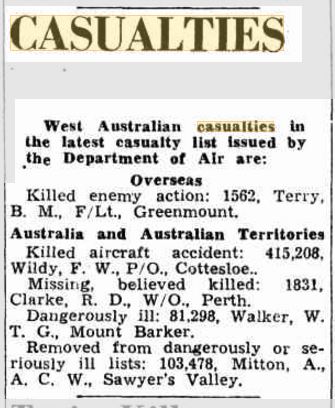 1. Understand what WWII newspapers may be available online
1. Understand what WWII newspapers may be available online
The major U.S. site for free digitized newspaper content, Chronicling America, recently started allowing post-1922 news, but it will take a while for copyright-cleared issues to post to the site (read more here.) Various state or local collections may vary; for example, the free Colorado Historical Newspaper Collection does have some WWII-era coverage.
Outside the U.S., Australia’s site Trove (which is free) does have digitized newspapers that include articles, like the 1942 casualty list from The Daily News (Perth), shown here. So do the overlapping British Newspaper Archive site and Findmypast.com’s British newspapers collection.
2. Explore premium and institutional databases for WWII newspapers
Start with digital newspaper content at free sites and subscription sites to which you have access. Then follow up with a trip to your local library, which likely offers additional historical newspaper databases. For example, in the U.S., these may include Access NewspaperARCHIVE, America’s GenealogyBank, America’s Historical Newspapers, America’s News, Newspaper Source, and ProQuest Historical Newspapers. Sometimes, you can access these databases from home with your library card log-in; if not, you’ll have to go to the library. (Genealogy Gems Premium members: check out Premium Podcast episode #125 for more great genealogical resources at public libraries.)
In the U.S., even these databases may only have limited coverage, such as titles from major cities for the 1940s. ProQuest Historical Newspapers has the Atlanta Constitution, Baltimore Sun, Boston Globe, Christian Science Monitor, New York Times, Wall Street Journal, and The Washington Post. Though these may not give you small-town details and perspectives on your own family, you will get a sense of the progress of the war from the perspective of those who were living through it, and how the public was responding.
3. Search for individual WWII newspapers
If you can’t find digitized content you want, widen your net. Search for titles of all active newspapers in your family’s city during the war. In the U.S., do that with the U.S. Newspaper Directory on Chronicling America. The same directory links to thousands of library holdings. WorldCat.org has even more; run a follow-up search here on any titles you don’t see holdings for on Chronicling America. If you’re local to where your family lived or can visit there, you may find copies at the public library. If you’re not local, you may have to try to order microfilmed copies through interlibrary loan. Ask your local Reference Librarian for assistance.
 Next, Google search for individual newspaper titles online. Though no longer actively digitizing and indexing newspapers, Google News Archive can help you locate online content for specific newspapers. Click here to access its alphabetical listing of newspapers. You can also enter keyword-searches in the search box on that webpage for all the newspapers listed there.
Next, Google search for individual newspaper titles online. Though no longer actively digitizing and indexing newspapers, Google News Archive can help you locate online content for specific newspapers. Click here to access its alphabetical listing of newspapers. You can also enter keyword-searches in the search box on that webpage for all the newspapers listed there.
As needed, run a follow-up Google search using the newspaper title, city, state, and date range; for the latter, use the format “1941..1945” with two periods between the dates and no spaces. This helps to filter your date range to these specific years.
Learn more about Googling your ancestors in newspapers, websites, books, photographs, and more in my book The Genealogist’s Google Toolbox.
What’s next?
 My book How to Find Your Family History in Newspapers is your ultimate guide to this topic, with tons of step-by-step instructions, online resources, and finding strategies. And, stay tuned for our up and coming post “Finding Family History in WWII Newspapers: Narrowing the Results” for more instructions on digitally searching WWII newspapers for war-related stories.
My book How to Find Your Family History in Newspapers is your ultimate guide to this topic, with tons of step-by-step instructions, online resources, and finding strategies. And, stay tuned for our up and coming post “Finding Family History in WWII Newspapers: Narrowing the Results” for more instructions on digitally searching WWII newspapers for war-related stories.

 You may have read our previous post on step-by-step instructions to using browse-only databases at FamilySearch. If you didn’t, you should know that when you are searching for records at FamilySearch using the traditional search fields, you are only searching for records that have been indexed. In other words, there may be thousands of records you need on the site, but you won’t find them. They have not been indexed by a searchable name, place, or date. Instead, you need to go in the virtual “back door.”
You may have read our previous post on step-by-step instructions to using browse-only databases at FamilySearch. If you didn’t, you should know that when you are searching for records at FamilySearch using the traditional search fields, you are only searching for records that have been indexed. In other words, there may be thousands of records you need on the site, but you won’t find them. They have not been indexed by a searchable name, place, or date. Instead, you need to go in the virtual “back door.”







 1. Understand what WWII newspapers may be available online
1. Understand what WWII newspapers may be available online
